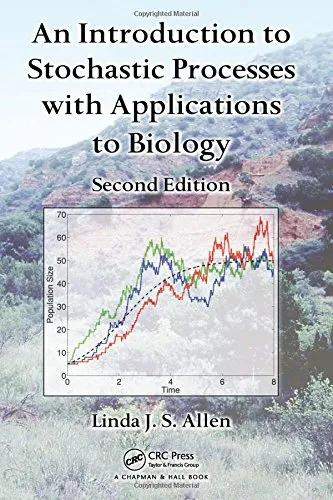An Introduction to Stochastic Processes with Applications to Biology, Second Edition
4.5
Reviews from our users

You Can Ask your questions from this book's AI after Login
Each download or ask from book AI costs 2 points. To earn more free points, please visit the Points Guide Page and complete some valuable actions.Introduction to "An Introduction to Stochastic Processes with Applications to Biology, Second Edition"
"An Introduction to Stochastic Processes with Applications to Biology, Second Edition" is a comprehensive textbook designed to introduce students, researchers, and practitioners to the principles and applications of stochastic processes in the field of biology. Written by Linda J. S. Allen, this book provides theoretical insights, computational tools, and real-world examples that bridge the gap between mathematical modeling and biological understanding. Updated and refined, this second edition includes more in-depth examples, a broader range of exercises, and cutting-edge research applications in biology, ensuring it remains an indispensable resource for learners and professionals alike.
Detailed Summary of the Book
Biological systems are inherently stochastic, involving randomness and variation over time. Processes such as population dynamics, genetic mutation, disease spread, and intracellular molecular interactions are all influenced by random events. This book serves as a gateway for readers to understand these stochastic phenomena through the lens of probability and mathematical modeling.
The text begins with basic probability theory as the backbone of stochastic processes, covering topics such as conditional probability, expectation, and variance. Introductory material is presented in a way that balances accessibility with mathematical rigor, making it suitable for readers with limited mathematical backgrounds.
Core topics explored in the book include Markov chains, Poisson processes, branching processes, birth-death processes, and diffusion models. Each stochastic concept is carefully developed with the intention of emphasizing its practical biological relevance. Applications span an array of biological fields, from modeling infectious diseases to studying population genetics, epidemiology, and cellular processes.
A significant feature of the book is its integration of biological examples to clarify abstract concepts. In each chapter, the reader encounters mathematical models applied to biological case studies. For example, students might analyze how random mutation rates impact microbial populations or how stochasticity influences the spread of an epidemic.
Furthermore, the second edition expands upon the computational aspects of stochastic processes. Chapters include simulation methods and instructions for generating numerical solutions to stochastic models, ensuring readers not only grasp theoretical underpinnings but also develop quantitative skills necessary for modern scientific inquiry.
Key Takeaways
- Foundational Concepts: Acquire a strong foundation in probability theory and stochastic process modeling applicable across biological sciences.
- Diverse Applications: Learn to model biological systems using stochastic approaches, ranging from genetic drift to epidemiological dynamics.
- Computational Skills: Develop the ability to simulate random processes and analyze the numerical behavior of stochastic models.
- Interdisciplinary Insight: Gain insight into real-world examples of how mathematics and biology intersect to tackle contemporary research problems.
- Flexible Learning: Benefit from the book’s balance between accessibility for beginners and depth for advanced readers.
Famous Quotes from the Book
"Randomness is not merely an artifact of our incomplete knowledge of biological systems, but a central feature of how nature operates." - Linda J. S. Allen
"Stochastic processes allow us to move beyond deterministic predictions and embrace variability, offering a deeper understanding of complex biological phenomena."
Why This Book Matters
In an era where biological data are increasingly rich and complex, understanding variability through stochastic processes has become essential. This book equips readers with the mathematical tools and conceptual insights to interpret and model randomness in biological systems. Whether you are a student of applied mathematics, a biologist intrigued by probabilistic modeling, or a researcher seeking to incorporate stochastic methods into your work, this second edition is indispensable.
Unlike other texts that focus solely on abstract mathematical concepts, this book places biological reality at the center of its discussion. It fosters a deep appreciation of how randomness shapes natural processes and helps readers translate that understanding into tangible insights.
Moreover, the inclusion of real-world examples, exercises, and computational tools makes this book not only a theoretical guide but also a practical resource. By following the principles in this book, learners can build robust models that capture the unpredictable nature of life itself.
Ultimately, "An Introduction to Stochastic Processes with Applications to Biology, Second Edition" contributes significantly to both mathematical education and biological research, reflecting how the interplay of disciplines can lead to new scientific breakthroughs.
Free Direct Download
Get Free Access to Download this and other Thousands of Books (Join Now)
For read this book you need PDF Reader Software like Foxit Reader


